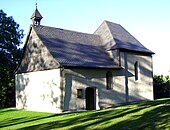Keffelker Chapel
The Keffelker Chapel near Brilon is the last remnant of the desolate settlement of Keffelke , originally called Caphlivun and later Kefflike . It is part of the patronage of St. Subordinated to Antonius Abbot.
History and architecture
The church area of the medieval village was the focus, it was surrounded by a wall. The ruined wall is still recognizable as a wall. A cemetery was laid out around the church, so it probably had the rank of a parish church. A priest Siffridus de keflike was named as a witness in a document in 1279.
The chapel is far away from any settlement in the landscape, directly on the historic road from Brilon to Marsberg on today's B7 . The local researcher Christoph Becker found out as early as the 19th century that it was the rest of the village of Keffelke.
It is fortunate that the chapel was not demolished to allow the stones to be reused, as in most other cases. The chapel consists of two parts that were built at different times. The eastern part probably dates from the 14th century and is now used as a choir room. The western, flat-roofed nave is from more recent times . The choir is higher than the nave and has a floor area of 7.3 mx 6.6 m. It has a late medieval cross vault . The ship is a simple rectangular building from 1582. A small bell hangs in the roof turret.
A first image of the chapel dates from 1570. Even today, services are held in the chapel. A circle of friends is committed to preserving it.
Furnishing
- Baroque altar
The wooden column retable with the figures of the Holy Family was made around 1750; according to a report in the Briloner Zeitung from 1895, it comes from the provost church . The altar was installed in the chapel in 1880 after extensive restoration. After World War II, he was re-by the church painter Kaup taken . In the lower area of the top are the figures of Aloysius von Conzage and Antonius von Padua , both wearing choir clothes. Aloysius carries a cross in his hand as an attribute , Antonius the baby Jesus. The Holy Family originally gave its name to the Jesus-Maria-Joseph Altar . Above it, the Holy Spirit and God the Father can be seen in a cloud. In the middle of the upper part, St. Anna is depicted with her daughter Maria, surrounded by putti . To the right and left of it are the figures of the Archangels Michael and Raphael. The altar is crowned by a halo with the inscription Maria , to the right and left of it sits a putti.
Other equipment
- In front of the baroque altar is a celebration altar made of oak, it was made in 2005.
- The communion bench is from around 1770 to 1780.
- Twelve wrought iron candle holders, the so-called twelve apostle chandeliers, are used for festive lighting.
- The origin of the 1.30 meter high terracotta figure of St. Anthony the Hermit is not known. She stands on a sandstone slab dressed in monk clothing. As an attribute Antonius carries a book with the inscription Pax and a staff in the shape of a cross. He is also the patron saint of domestic animals, at his feet is a mighty boar , the so-called Antonius pig.
- The figure of St. Peter is 1.40 meters high and stands on a slab of green sandstone. The age and origin of the figure are not known.
- The figure of St. Peter is made of plaster and is 85 cm high. It is endowed with the attributes of a Bible and a key. The figure is on permanent loan from the holdings of the Archdiocese of Paderborn .
- The fourteen plates of the Way of the Cross were stored on the floor of the Marienkapelle in the St. Petrus and Andreas Propsteikirche until 2004, they were newly colored.
- The 1.50 meter high, framed oak panels, with the depictions of Christ ascending into heaven and Our Lady hang on the south wall of the choir . They were part of an altar that stood in the chapel until the 19th century. Remains are still preserved to the left of today's altar.
- On the north wall of the choir hangs a 1.20 meter high cross that was previously kept in the provost church. It bears the number 1867.
Individual evidence
- ↑ Gerhard Brökel: Past times history from Brilon. P. 24 and 25th
- ^ A b Georg Dehio : Handbook of German Art Monuments, North Rhine-Westphalia . Volume 2: Westphalia. Deutscher Kunstverlag, Munich 1969, p. 85.
- ^ Report on the Circle of Friends
- ↑ Georg Dehio; Ursula Quednau (scientific director): Handbook of German art monuments. North Rhine-Westphalia. Volume II: Westphalia . Deutscher Kunstverlag, Munich 2011, ISBN 978-3-422-03114-2 , p. 195.
literature
- Heinz Günter Horn (Ed.): Theiss Archaeological Guide. Westphalia-Lippe. Stuttgart 2008, ISBN 978-3-8062-2218-0 , p. 57f.
- Georg Dehio : Handbook of the German art monuments, North Rhine-Westphalia . Volume 2: Westphalia. Deutscher Kunstverlag, Munich 1969.
- Heinrich Hülsbusch St. Antonius Chapel Ed. Propsteigemeinde Brilon
Web links
Coordinates: 51 ° 24 ′ 17.8 " N , 8 ° 37 ′ 30.6" E




